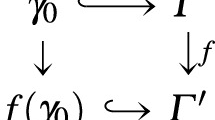Abstract
An appropriate framework is put forward for the construction of \(\lambda \)-models with \(\infty \)-groupoid structure, which we call homotopic \(\lambda \)-models, through the use of an \(\infty \)-category with cartesian closure and enough points. With this, we establish the start of a project of generalization of Domain Theory and \(\lambda \)-calculus, in the sense that the concept of proof (path) of equality of \(\lambda \)-terms is raised to higher proof (homotopy).


Similar content being viewed by others
Notes
References
Martínez-Rivillas, D., de Queiroz, R.: The theory of an arbitrary higher \(\lambda \)-model, arXiv:2111.07092
de Queiroz, R., de Oliveira, A., Ramos, A.: Propositional equality, identity types, and direct computational paths. South Am. J. Logic 2(2), 245–296 (2016)
Ramos, A., de Queiroz, R., de Oliveira, A.: On the identity type as the type of computational paths. Logic J. IGPL 25(4), 562–584 (2017)
Martínez-Rivillas, D., de Queiroz, R.: The \(\infty \)-groupoid generated by an arbitrary topological \(\lambda \)-model. Logic J. IGPL 30(3), 465–488 (2022). https://doi.org/10.1093/jigpal/jzab015. arXiv:1906.05729
Kapulkin, C., Lumsdaine, P., Voevodsky, V.: The simplicial model of univalent foundations, arXiv:1211.2851
Lumsdaine, P., Shulman, M.: Semantics of higher inductive types. Math. Proc. Cambridge Philos. Soc. 169, 159–208 (2020)
Program, T.U.F.: Homotopy Type Theory: Univalent Foundations of Mathematics, Princeton. Institute for Advanced Study, Princeton (2013)
Lurie, J.: Higher Topos Theory. Princeton University Press, Princeton and Oxford (2009)
Hyland, M.: Some reasons for generalizing domain theory. Math. Struct. Comput. Sci. 20, 239–265 (2010)
Goerss, P., Jardine, J.: Simplicial Homotopy Theory. Birkhäuser Basel, Springer, Switzerl (2009)
Friedman, G.: An elementary illustrated introduction to simplicial sets. Rocky Mountain J. Math. 42(2), 353–423 (2012)
Cisinski, D.-C.: Higher Categories and Homotopical Algebra. Cambridge University Press, Cambridge (2019)
Rezk, C.: Stuff about quasicategories. In Lecture Notes for course at University of Illinois at Urbana-Champaign (2017)
Groth, M.: A short course on \(\infty \)-categories, (2015). https://arxiv.org/abs/1007.2925
Joyal, A.: Quasi-categories and kan complexes. J. Pure Appl. Algebra 175(1), 207–222 (2002)
Barendregt, H.: The Lambda Calculus, its Syntax and Semantics. North-Holland Co., Amsterdam (1984)
Hindley, J., Seldin, J.: Lambda-Calculus and Combinators: An Introduction. Cambridge University Press, New York (2008)
Martínez-Rivillas, D., de Queiroz, R.: Solving homotopy domain equations. arXiv:2104.01195
Hyland, M.: Elements of a theory of algebraic theories. Theoret. Comput. Sci. 546, 132–144 (2014)
Author information
Authors and Affiliations
Corresponding author
Additional information
Publisher's Note
Springer Nature remains neutral with regard to jurisdictional claims in published maps and institutional affiliations.
Rights and permissions
Springer Nature or its licensor (e.g. a society or other partner) holds exclusive rights to this article under a publishing agreement with the author(s) or other rightsholder(s); author self-archiving of the accepted manuscript version of this article is solely governed by the terms of such publishing agreement and applicable law.
About this article
Cite this article
Martínez-Rivillas, D.O., de Queiroz, R.J.G.B. Towards a homotopy domain theory. Arch. Math. Logic 62, 559–579 (2023). https://doi.org/10.1007/s00153-022-00856-0
Received:
Accepted:
Published:
Issue Date:
DOI: https://doi.org/10.1007/s00153-022-00856-0




